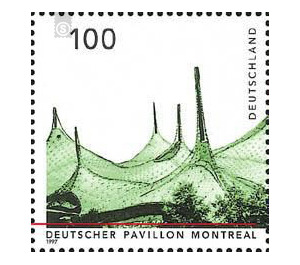Block stamp: german architecture after 1945 - Germany / Federal Republic of Germany 1997 - 100 Pfennig
Theme: Architecture
| Country | Germany / Federal Republic of Germany |
| Issue Date | 1997 |
| Face Value | 100.00 |
| Color | multi-colored blue |
| Perforation | Ks 13 3/4 |
| Printing Type | Multicolor offset printing |
| Stamp Type | Postage stamp |
| Item Type | Stamp |
| Chronological Issue Number | 1782 |
| Chronological Chapter | GER-BRD |
| SID | 651974 |
| In 20 Wishlists | |
Four different architectural positions stand for the variety of currents in German architecture since 1945. Hans Scharoun represents the "organic building" with his »Philharmonie« from 1960 to 1963 in Berlin. The music should also form the center of the concert happening in the area. Therefore, Scharoun developed a multi-layered spatial structure in which the audience ranks rise around the podium like the terraces of a vineyard. In close proximity to the »Philharmonie« lies the »New National Gallery« by Ludwig Mies van der Rohe, which was realized from 1962 to 1968. Mies van der Rohe claimed order and clarity of the architectural form for his building. A roof resting on steel supports over the glass, undivided temporary exhibition hall, while the show collection is housed in the base floor. At the same time (1968), the pilgrimage church »Maria, Queen of Peace« was consecrated by Gottfried Böhm in Neviges. The architect uses a strongly rugged, plastically modeled roofscape as a striking motif. The terraced pilgrimage leads to a monumental »architectural sculpture« of reinforced concrete. World exhibitions have always been an important forum for the presentation of the latest architectural developments and trends. Thus, the Federal Republic of Germany presented itself in Montreal in 1967 with a light tent construction made from a filigree rope net construction with a suspended, translucent membrane. This pavilion by Frei Otto was one of the most outstanding architectural events of the World's Fair. (Text: Peter Daners M.A., Bonn)


